Elisa Kreiss
Measuring Bias or Measuring the Task: Understanding the Brittle Nature of LLM Gender Biases
Sep 04, 2025Abstract:As LLMs are increasingly applied in socially impactful settings, concerns about gender bias have prompted growing efforts both to measure and mitigate such bias. These efforts often rely on evaluation tasks that differ from natural language distributions, as they typically involve carefully constructed task prompts that overtly or covertly signal the presence of gender bias-related content. In this paper, we examine how signaling the evaluative purpose of a task impacts measured gender bias in LLMs. Concretely, we test models under prompt conditions that (1) make the testing context salient, and (2) make gender-focused content salient. We then assess prompt sensitivity across four task formats with both token-probability and discrete-choice metrics. We find that even minor prompt changes can substantially alter bias outcomes, sometimes reversing their direction entirely. Discrete-choice metrics further tend to amplify bias relative to probabilistic measures. These findings do not only highlight the brittleness of LLM gender bias evaluations but open a new puzzle for the NLP benchmarking and development community: To what extent can well-controlled testing designs trigger LLM ``testing mode'' performance, and what does this mean for the ecological validity of future benchmarks.
CHART-6: Human-Centered Evaluation of Data Visualization Understanding in Vision-Language Models
May 22, 2025Abstract:Data visualizations are powerful tools for communicating patterns in quantitative data. Yet understanding any data visualization is no small feat -- succeeding requires jointly making sense of visual, numerical, and linguistic inputs arranged in a conventionalized format one has previously learned to parse. Recently developed vision-language models are, in principle, promising candidates for developing computational models of these cognitive operations. However, it is currently unclear to what degree these models emulate human behavior on tasks that involve reasoning about data visualizations. This gap reflects limitations in prior work that has evaluated data visualization understanding in artificial systems using measures that differ from those typically used to assess these abilities in humans. Here we evaluated eight vision-language models on six data visualization literacy assessments designed for humans and compared model responses to those of human participants. We found that these models performed worse than human participants on average, and this performance gap persisted even when using relatively lenient criteria to assess model performance. Moreover, while relative performance across items was somewhat correlated between models and humans, all models produced patterns of errors that were reliably distinct from those produced by human participants. Taken together, these findings suggest significant opportunities for further development of artificial systems that might serve as useful models of how humans reason about data visualizations. All code and data needed to reproduce these results are available at: https://osf.io/e25mu/?view_only=399daff5a14d4b16b09473cf19043f18.
MOSAIC: Modeling Social AI for Content Dissemination and Regulation in Multi-Agent Simulations
Apr 10, 2025Abstract:We present a novel, open-source social network simulation framework, MOSAIC, where generative language agents predict user behaviors such as liking, sharing, and flagging content. This simulation combines LLM agents with a directed social graph to analyze emergent deception behaviors and gain a better understanding of how users determine the veracity of online social content. By constructing user representations from diverse fine-grained personas, our system enables multi-agent simulations that model content dissemination and engagement dynamics at scale. Within this framework, we evaluate three different content moderation strategies with simulated misinformation dissemination, and we find that they not only mitigate the spread of non-factual content but also increase user engagement. In addition, we analyze the trajectories of popular content in our simulations, and explore whether simulation agents' articulated reasoning for their social interactions truly aligns with their collective engagement patterns. We open-source our simulation software to encourage further research within AI and social sciences.
Updating CLIP to Prefer Descriptions Over Captions
Jun 12, 2024Abstract:Although CLIPScore is a powerful generic metric that captures the similarity between a text and an image, it fails to distinguish between a caption that is meant to complement the information in an image and a description that is meant to replace an image entirely, e.g., for accessibility. We address this shortcoming by updating the CLIP model with the Concadia dataset to assign higher scores to descriptions than captions using parameter efficient fine-tuning and a loss objective derived from work on causal interpretability. This model correlates with the judgements of blind and low-vision people while preserving transfer capabilities and has interpretable structure that sheds light on the caption--description distinction.
CommVQA: Situating Visual Question Answering in Communicative Contexts
Feb 22, 2024Abstract:Current visual question answering (VQA) models tend to be trained and evaluated on image-question pairs in isolation. However, the questions people ask are dependent on their informational needs and prior knowledge about the image content. To evaluate how situating images within naturalistic contexts shapes visual questions, we introduce CommVQA, a VQA dataset consisting of images, image descriptions, real-world communicative scenarios where the image might appear (e.g., a travel website), and follow-up questions and answers conditioned on the scenario. We show that CommVQA poses a challenge for current models. Providing contextual information to VQA models improves performance broadly, highlighting the relevance of situating systems within a communicative scenario.
ContextRef: Evaluating Referenceless Metrics For Image Description Generation
Sep 21, 2023



Abstract:Referenceless metrics (e.g., CLIPScore) use pretrained vision--language models to assess image descriptions directly without costly ground-truth reference texts. Such methods can facilitate rapid progress, but only if they truly align with human preference judgments. In this paper, we introduce ContextRef, a benchmark for assessing referenceless metrics for such alignment. ContextRef has two components: human ratings along a variety of established quality dimensions, and ten diverse robustness checks designed to uncover fundamental weaknesses. A crucial aspect of ContextRef is that images and descriptions are presented in context, reflecting prior work showing that context is important for description quality. Using ContextRef, we assess a variety of pretrained models, scoring functions, and techniques for incorporating context. None of the methods is successful with ContextRef, but we show that careful fine-tuning yields substantial improvements. ContextRef remains a challenging benchmark though, in large part due to the challenge of context dependence.
Context-VQA: Towards Context-Aware and Purposeful Visual Question Answering
Jul 28, 2023

Abstract:Visual question answering (VQA) has the potential to make the Internet more accessible in an interactive way, allowing people who cannot see images to ask questions about them. However, multiple studies have shown that people who are blind or have low-vision prefer image explanations that incorporate the context in which an image appears, yet current VQA datasets focus on images in isolation. We argue that VQA models will not fully succeed at meeting people's needs unless they take context into account. To further motivate and analyze the distinction between different contexts, we introduce Context-VQA, a VQA dataset that pairs images with contexts, specifically types of websites (e.g., a shopping website). We find that the types of questions vary systematically across contexts. For example, images presented in a travel context garner 2 times more "Where?" questions, and images on social media and news garner 2.8 and 1.8 times more "Who?" questions than the average. We also find that context effects are especially important when participants can't see the image. These results demonstrate that context affects the types of questions asked and that VQA models should be context-sensitive to better meet people's needs, especially in accessibility settings.
Context Matters for Image Descriptions for Accessibility: Challenges for Referenceless Evaluation Metrics
May 21, 2022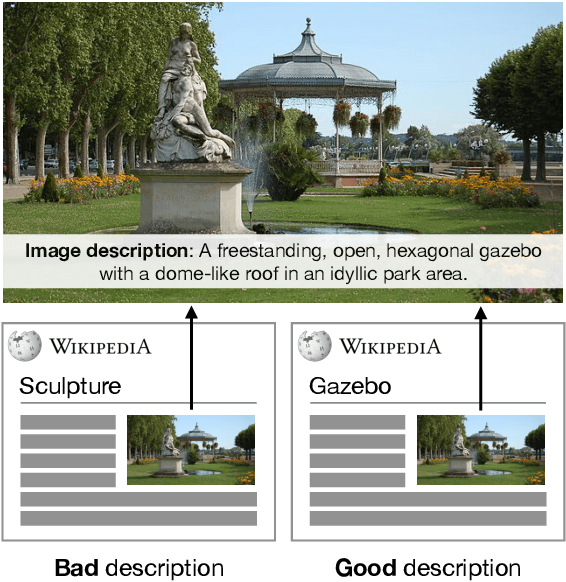
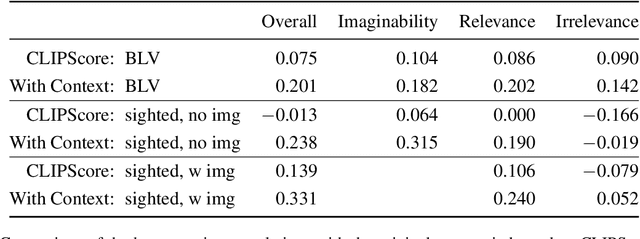


Abstract:Few images on the Web receive alt-text descriptions that would make them accessible to blind and low vision (BLV) users. Image-based NLG systems have progressed to the point where they can begin to address this persistent societal problem, but these systems will not be fully successful unless we evaluate them on metrics that guide their development correctly. Here, we argue against current referenceless metrics -- those that don't rely on human-generated ground-truth descriptions -- on the grounds that they do not align with the needs of BLV users. The fundamental shortcoming of these metrics is that they cannot take context into account, whereas contextual information is highly valued by BLV users. To substantiate these claims, we present a study with BLV participants who rated descriptions along a variety of dimensions. An in-depth analysis reveals that the lack of context-awareness makes current referenceless metrics inadequate for advancing image accessibility, requiring a rethinking of referenceless evaluation metrics for image-based NLG systems.
Color Overmodification Emerges from Data-Driven Learning and Pragmatic Reasoning
May 18, 2022Abstract:Speakers' referential expressions often depart from communicative ideals in ways that help illuminate the nature of pragmatic language use. Patterns of overmodification, in which a speaker uses a modifier that is redundant given their communicative goal, have proven especially informative in this regard. It seems likely that these patterns are shaped by the environment a speaker is exposed to in complex ways. Unfortunately, systematically manipulating these factors during human language acquisition is impossible. In this paper, we propose to address this limitation by adopting neural networks (NN) as learning agents. By systematically varying the environments in which these agents are trained, while keeping the NN architecture constant, we show that overmodification is more likely with environmental features that are infrequent or salient. We show that these findings emerge naturally in the context of a probabilistic model of pragmatic communication.
Causal Distillation for Language Models
Dec 05, 2021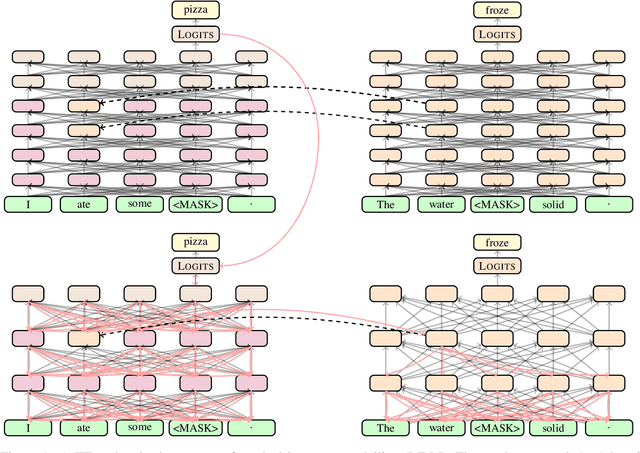

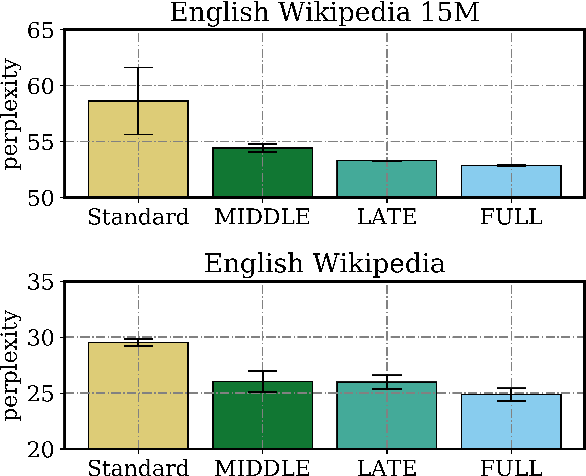
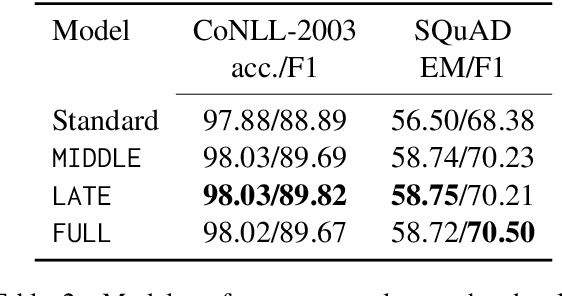
Abstract:Distillation efforts have led to language models that are more compact and efficient without serious drops in performance. The standard approach to distillation trains a student model against two objectives: a task-specific objective (e.g., language modeling) and an imitation objective that encourages the hidden states of the student model to be similar to those of the larger teacher model. In this paper, we show that it is beneficial to augment distillation with a third objective that encourages the student to imitate the causal computation process of the teacher through interchange intervention training(IIT). IIT pushes the student model to become a causal abstraction of the teacher model - a simpler model with the same causal structure. IIT is fully differentiable, easily implemented, and combines flexibly with other objectives. Compared with standard distillation of BERT, distillation via IIT results in lower perplexity on Wikipedia (masked language modeling) and marked improvements on the GLUE benchmark (natural language understanding), SQuAD (question answering), and CoNLL-2003 (named entity recognition).
 Add to Chrome
Add to Chrome Add to Firefox
Add to Firefox Add to Edge
Add to Edge